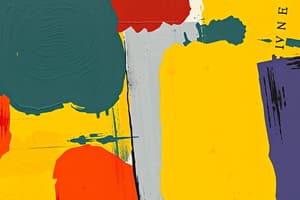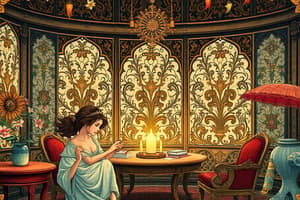Podcast
Questions and Answers
Which genre is characterized by stories told primarily through simulated social network exchanges?
Which genre is characterized by stories told primarily through simulated social network exchanges?
- Flash Fiction
- Text-Talk Novels (correct)
- Chick Lit
- Doodle Fiction
Creative Non-Fiction is primarily concerned with technical accuracy over literary style.
Creative Non-Fiction is primarily concerned with technical accuracy over literary style.
False (B)
What is the Japanese term for comics that has been adopted in English to refer to Japanese comic books and graphic novels?
What is the Japanese term for comics that has been adopted in English to refer to Japanese comic books and graphic novels?
Manga
________ is a style of fictional literature known for its extreme brevity, ranging from a single word to a thousand.
________ is a style of fictional literature known for its extreme brevity, ranging from a single word to a thousand.
Match the following Manga genres with their target demographics:
Match the following Manga genres with their target demographics:
Which of the following best describes a key difference between traditional poetry and 21st-century literary forms?
Which of the following best describes a key difference between traditional poetry and 21st-century literary forms?
Digi-Fiction requires the reader to engage with content across book, movie/video, and internet website to fully understand the story.
Digi-Fiction requires the reader to engage with content across book, movie/video, and internet website to fully understand the story.
What percentage of the narrative is presented without words in an illustrated novel?
What percentage of the narrative is presented without words in an illustrated novel?
In 21st-century literature, a genre that combines a book, a movie/video, and an internet website is known as ______.
In 21st-century literature, a genre that combines a book, a movie/video, and an internet website is known as ______.
Match the genre with its description:
Match the genre with its description:
Flashcards
Poetry
Poetry
Imaginative awareness expressed through meaning, sound, and rhythm.
Drama
Drama
A composition in prose or verse, often performed on stage, involving conflict or contrast of character.
Fiction
Fiction
Literature created from imagination, not presented as fact, though it may be based on true events.
Non-Fiction
Non-Fiction
Signup and view all the flashcards
Illustrated Novel
Illustrated Novel
Signup and view all the flashcards
Manga
Manga
Signup and view all the flashcards
Doodle Fiction
Doodle Fiction
Signup and view all the flashcards
Text-Talk Novels
Text-Talk Novels
Signup and view all the flashcards
Chick Lit
Chick Lit
Signup and view all the flashcards
Flash Fiction
Flash Fiction
Signup and view all the flashcards
Study Notes
- The module aims to differentiate 21st-century literary genres from original ones, enumerate elements, structures, and traditions, and appreciate unique features of each genre.
Poetry
- Expresses imaginative awareness through meaning, sound, and rhythmic language.
- Employs meter and rhyme.
- Its individual expression makes it hard to define.
Drama
- Is a composition in prose or verse presented in dialogue or pantomime.
- It involves conflict or contrast of character.
- Are intended to be acted on a stage, such as a play.
- Involve vivid, emotional, conflicting, or striking events.
Fiction
- Literature created from imagination, not presented as fact, though based on a true story is possible.
- Includes novels, short stories, and novellas.
Non-Fiction
- Based on author's opinion and facts.
- Aims to persuade or inform.
- Examples include biographies, articles from textbooks, magazines, and newspapers.
Illustrated Novel
- Tell stories through text and illustrated images.
- Fifty percent of the narrative is presented without words.
- Readers interpret images to comprehend the story,
- Textual portions are in traditional form, but some novels contain no text.
- Spans all genres.
- The Invention of Hugo Cabret by Brian Selznick, and The Arrival by Shaun Tan are examples.
Digi-Fiction
- Falls under triple media literature
- Combines books, movies/videos, and internet websites.
- Full story requires engagement in navigation, reading, and viewing in all three forms.
- Skeleton Creek by Patrick Carman and Level 26 by Anthony Zuiker are examples.
Manga
- A Japanese word for comics used in the English-speaking world for comic books and graphic novels originally published in Japan.
- Is an artistic and storytelling style.
- Ameri-manga refers to comics created by American artists in manga style.
- Shonen is boy's manga, like Naruto, Bleach, and One Piece.
- Shojo is girl's manga, like Sailormoon.
- Seinen is men's manga, such as Akira.
- Josei is women's manga, such as Loveless and Paradise Kiss.
- Kodomo is children's manga, such as Doraemon and Hello Kitty.
Doodle Fiction
- Literary presentations where the author incorporates doodle writing, drawings and handwritten graphics in place of the traditional font.
- Drawing enhances the story, often adding humorous elements.
- The Diary of a Wimpy Kid by Jeff Kinney and Timmy Failure by Stephan Pastis are examples.
Text-Talk Novel
- Blogs, email, and IM form the narratives.
- Stories are almost entirely told in dialogue to simulate social network exchanges.
Chick Lit or Chick Literature
- Is a genre fiction that addresses issues of modern womanhood in a humorous, lighthearted way.
- Features a female protagonist whose femininity heavily thematizes the plot.
- The Night Before Christmas by Scarlet Bailey and It Started with a Kiss by Miranda Dickinson are examples.
Flash Fiction
- Fictional literature of extreme brevity, ranging from a word to a thousand, with no widely accepted definition.
Six-Word Flash Fiction
- "For sale: baby socks, never worn." by Ernest Hemingway
- "Longed for him. Got him, Shit." by Margaret Atwood.
Creative Non-Fiction
- Also Known as literary non-fiction or narrative non-fiction
- A genre of writing that uses literary styles and techniques to create factually accurate narratives.
- Contrasts with other non-fiction, such as technical writing or journalism because its not written in service to its craft.
- Creative non-fiction is relatively young and only beginning to be scrutinized with the same critical analysis given to fiction and poetry.
- 1000 Gifts by Ann Voscamp and Wind, Sand, and Stars by Antoine de Saint-Exupery are examples.
Science Fiction
- Speculative fiction dealing with imaginative concepts.
- Includes futuristic science and technology, space travel, time travel, faster than light travel, a parallel universe, and extra-terrestrial life.
- Explores the potential consequences of scientific and other innovations, called a "literature of ideas".
- Examples include Suzanne Collins' Mockingjay and Sarah Maas' Kingdom of Ash.
Blog
- A weblog, a website containing short articles called posts that are changed regularly.
- Some are written by one person with their own opinions, interests and experiences, while others are written by different people.
Hyper Poetry
- Digital poetry that uses links and hypertext mark-up.
- Involves set words, phrases, lines, etc., presented in variable order and parts of the poem may move and transform.
- Found online, CD-ROM, and diskette versions exist.
- The earliest examples date to no later than the mid-1980's.
Studying That Suits You
Use AI to generate personalized quizzes and flashcards to suit your learning preferences.
Related Documents
Description
Explore 21st-century and original literary genres. The module differentiates between genres like poetry, drama, fiction, and non-fiction. It also covers elements, structures, and unique features of each genre, enhancing literary appreciation.



